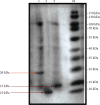Characterisation of Bacteriocins Produced by Lactobacillus spp. Isolated from the Traditional Pakistani Yoghurt and Their Antimicrobial Activity against Common Foodborne Pathogens
- PMID: 33005689
- PMCID: PMC7503110
- DOI: 10.1155/2020/8281623
Characterisation of Bacteriocins Produced by Lactobacillus spp. Isolated from the Traditional Pakistani Yoghurt and Their Antimicrobial Activity against Common Foodborne Pathogens
Abstract
Lactic acid bacteria (LAB) are widely known for their probiotic activities for centuries. These bacteria synthesise some secretory proteinaceous toxins, bacteriocins, which help destroy similar or interrelated bacterial strains. This study was aimed at characterising bacteriocins extracted from Lactobacillus spp. found in yoghurt and assessing their bactericidal effect on foodborne bacteria. Twelve isolated Lactobacillus spp. were examined to produce bacteriocins by the organic solvent extraction method. Bacteriocins produced by two of these strains, Lactobacillus helveticus (BLh) and Lactobacillus plantarum (BLp), showed the most significant antimicrobial activity, especially against Staphylococcus aureus and Acinetobacter baumannii. Analysis of SDS-PAGE showed that L. plantarum and L. helveticus bacteriocins have a molecular weight of ~10 kDa and ~15 kDa, respectively. L. plantarum (BLp) bacteriocin was heat stable while L. helveticus (BLh) bacteriocin was heat labile. Both bacteriocins have shown activity at acidic pH. Exposure to a UV light enhances the activity of the BLh; however, it had negligible effects on the BLp. Different proteolytic enzymes confirmed the proteinaceous nature of both the bacteriocins. From this study, it was concluded that bacteriocin extracts from L. helveticus (BLh) can be considered a preferable candidate against foodborne pathogens as compared to L. plantarum (BLp). These partially purified bacteriocins should be further processed to attain purified product that could be useful for food spoilage and preservation purposes.
Copyright © 2020 Mahreen Ul Hassan et al.
Conflict of interest statement
The authors report no conflict of interest.
Figures


Similar articles
-
Probiotic Properties of Lactobacillus helveticus and Lactobacillus plantarum Isolated from Traditional Pakistani Yoghurt.Biomed Res Int. 2020 Dec 24;2020:8889198. doi: 10.1155/2020/8889198. eCollection 2020. Biomed Res Int. 2020. PMID: 33426082 Free PMC article.
-
Potential of lactic acid bacteria isolated from specific natural niches in food production and preservation.Int J Food Microbiol. 2006 Dec 1;112(3):230-5. doi: 10.1016/j.ijfoodmicro.2006.04.009. Epub 2006 Jun 9. Int J Food Microbiol. 2006. PMID: 16764959
-
Characterization and purification of a new bacteriocin with a broad inhibitory spectrum produced by Lactobacillus plantarum lp 31 strain isolated from dry-fermented sausage.J Appl Microbiol. 2009 Jun;106(6):2031-40. doi: 10.1111/j.1365-2672.2009.04173.x. Epub 2009 Mar 19. J Appl Microbiol. 2009. PMID: 19302495
-
Bacteriocins, A Natural Weapon Against Bacterial Contamination for Greater Safety and Preservation of Food: A Review.Curr Pharm Biotechnol. 2021;22(2):216-231. doi: 10.2174/1389201021666200704145427. Curr Pharm Biotechnol. 2021. PMID: 32621714 Review.
-
Lactobacillus salivarius: bacteriocin and probiotic activity.Food Microbiol. 2013 Dec;36(2):296-304. doi: 10.1016/j.fm.2013.05.010. Epub 2013 Jun 15. Food Microbiol. 2013. PMID: 24010610 Review.
Cited by
-
Transient comparison of techniques to counter multi-drug resistant bacteria: prime modules in curation of bacterial infections.Front Antibiot. 2024 Jan 26;2:1309107. doi: 10.3389/frabi.2023.1309107. eCollection 2023. Front Antibiot. 2024. PMID: 39816650 Free PMC article. Review.
-
Biopreservation of Food Using Bacteriocins From Lactic Acid Bacteria: Classification, Mechanisms, and Commercial Applications.Int J Microbiol. 2024 Nov 28;2024:8723968. doi: 10.1155/ijm/8723968. eCollection 2024. Int J Microbiol. 2024. PMID: 39641100 Free PMC article. Review.
-
Enhanced production of bacteriocin by Bacillus subtilis ZY05.3 Biotech. 2024 Feb;14(2):37. doi: 10.1007/s13205-023-03883-7. Epub 2024 Jan 12. 3 Biotech. 2024. PMID: 38221991 Free PMC article.
-
Probiotics, Their Extracellular Vesicles and Infectious Diseases.Front Microbiol. 2022 Mar 30;13:864720. doi: 10.3389/fmicb.2022.864720. eCollection 2022. Front Microbiol. 2022. PMID: 35432276 Free PMC article. Review.
-
Genome mining of Lactiplantibacillus plantarum PA21: insights into its antimicrobial potential.BMC Genomics. 2024 Jun 6;25(1):571. doi: 10.1186/s12864-024-10451-7. BMC Genomics. 2024. PMID: 38844835 Free PMC article.
References
-
- Muhammad Z., Ramzan R., Abdelazez A., et al. Assessment of the antimicrobial potentiality and functionality of Lactobacillus plantarum strains isolated from the conventional inner Mongolian fermented cheese against foodborne pathogens. Pathogens. 2019;8(2):p. 71. doi: 10.3390/pathogens8020071. - DOI - PMC - PubMed
-
- Yazdi M. K. S., Davoodabadi A., Zarin H. R. K., Ebrahimi M. T., Dallal M. M. S. Characterisation and probiotic potential of lactic acid bacteria isolated from Iranian traditional yogurts. Italian Journal of Animal Science. 2017;16(2):185–188. doi: 10.1080/1828051X.2016.1222888. - DOI
-
- Bilková A., Sepova H. K., Bilka F., Balázová A. Bacteriocins produced by lactic acid bacteria. Ceská a Slovenská Farmacie. 2011;60(2):65–72. - PubMed
MeSH terms
Substances
LinkOut - more resources
Full Text Sources
Medical
Miscellaneous

